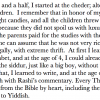6: Memoir excerpt, Peretz Litmann’s "The Boy From Munkács: The Story of a Survivor," 1996, translation from Hebrew.
In his memoir of life before, during, and after the Holocaust, survivor Peretz Litmann discusses his childhood growing up in the Hungarian shtetl of Munkács (in Yiddish, Munkatsh; now found in the Ukraine and known as Mukacheve). As Litmann indicates, khumesh (the Five Books of Moses) would be learned at kheyder thus: read aloud in its Hebrew original, with the recitation being interrupted regularly to render it into Yiddish.
Suggested activity: Of course, we also find reminiscences like this one, of khadorim where students and teachers learned together ably and with enthusiasm. Now have your class do the same. Pull out copies of the Hebrew Bible—if the students are able, the Hebrew original, and if not, a translation. Pick any passage, using a suggestion from the students. Now, proceeding verse by verse, have each student read out from the original, pausing every few words to translate into colloquial English. The traditional kheyder rhythm for this would be as follows (Ashkenazic pronunciation of the Hebrew original in bold, Yiddish translation in italics): “Bereyshis In onheyb; boro eloyhim hot got bashafn; es hashomayim ve-es ha-orets dem himl un di erd.” (If using a Bible is ill-suited to your classroom, choose any difficult text, like a poem, and work through it accordingly, each student stopping every few words to “translate” the poetic text. The aim is to replicate the rhythms of kheyder learning.)
Source: Peretz Litmann, Ha-na’ar mi-munkatsh: Sipuro shel nitzol (The Boy from Munkács: A Survivor’s Story) (Haifa: 1996), 16-17, trans. in “Prewar Jewish Life in Munkács: A Brief History,” Yad Vashem’s International School for Holocaust Studies, accessed December 4, 2015, http://www.yadvashem.org/yv/en/education/newsletter/31/jewish_life_munkacs.asp.
kheyder_06_litmann_memoir.png
 Download image (140.49 KB)
Download image (140.49 KB)

